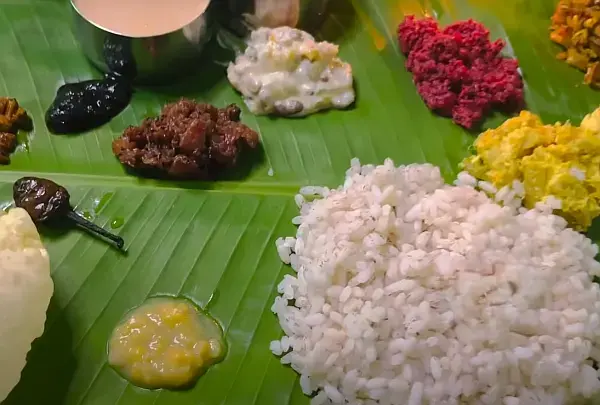Home > Flavours > Kerala Sadya
Kerala Sadya
A Traditional Vegetarian Feast on a Banana Leaf

The Kerala Sadya, often referred to as a "feast on a leaf," is a traditional vegetarian meal in Kerala, India. It’s a vibrant, multi-course meal served during festivals, weddings, and celebrations, showcasing the diverse flavors and textures of Kerala’s culinary heritage. Each component of a Sadya has cultural and symbolic significance, representing the harmony between flavors and the importance of balance in life. Here’s everything you need to know about this exquisite dining experience.
Origins and Cultural Significance of Sadya
Sadya, meaning "banquet" in Malayalam, is deeply rooted in Kerala's cultural and religious practices. Traditionally, Sadya is served during Onam, the harvest festival of Kerala, celebrating the return of the legendary King Mahabali. In weddings and other major celebrations, Sadya symbolizes prosperity, unity, and the abundance of nature. A Sadya is served on a banana leaf—a practice that adds to the flavors and is eco-friendly. The sequence of items, starting from sweet to sour, and their position on the leaf carry symbolic meanings and are intended to prepare the palate for the entire meal.
The Arrangement and Rituals of Sadya
Each item in a Sadya is served in a specific order and position on the banana leaf. The leaf is placed with the narrow end facing the left, and guests sit cross-legged on the floor to eat, maintaining a respectful and humble approach to dining. The Sadya usually includes 24 to 28 dishes, though on special occasions, it can extend to over 40 items. It’s served in a clockwise arrangement, with pickles, chips, and sweet items on the left and main dishes like curries and rice in the center.
Key Components of a Traditional Kerala Sadya
- Rice: The base of the Sadya, typically served in a generous heap, is parboiled rice, providing a neutral backdrop for the array of flavors.
- Parippu: A simple dal curry made with mung beans, often topped with a dollop of ghee, and mixed with rice to start the meal.
- Sambar: A staple in South Indian cuisine, Kerala-style sambar is made with lentils, tamarind, and vegetables like drumsticks, eggplant, and pumpkin, offering a tangy, earthy flavor.
- Avial: A creamy blend of mixed vegetables cooked in coconut, green chilies, and yogurt, avial is mildly spiced and has a distinctive flavor that balances the spicier dishes.
- Kaalan: Made with raw banana and yam, cooked in a yogurt and coconut paste, Kaalan has a thick, tangy texture, creating a contrast to other curries.
- Olan: A gentle, subtle curry with ash gourd and black-eyed peas, cooked in coconut milk and spiced lightly with green chilies and curry leaves. Its mildness adds variety to the meal.
- Thoran: A dry vegetable dish, usually prepared with grated coconut, mustard seeds, and curry leaves, featuring vegetables like cabbage, beans, or beetroot.
- Pachadi and Kichadi: Pachadi (made from sweet fruits or vegetables with yogurt and coconut) and Kichadi (spicy yogurt-based with cucumber or bitter gourd) add creamy and tangy flavors to the meal.
- Pulissery: A yogurt-based curry with turmeric and spices, often prepared with ripe mangoes for a sweet, tangy flavor that complements the other dishes.
- Rasam: A spicy, tangy soup with tomatoes, tamarind, and spices, Rasam is typically enjoyed as a palate cleanser toward the end of the meal.
- Pickles and Condiments: Mango and lime pickles provide a burst of tartness, while injipuli (a ginger-tamarind chutney) offers a unique blend of spicy, sweet, and sour flavors.
- Chips and Pappadam: Banana chips, sharkara varatti (jaggery-coated banana chips), and crispy pappadam add a crunchy texture to the feast, balancing the soft curries and rice.
- Payasam: The grand finale of Sadya, payasam is a sweet dessert often served in multiple varieties, such as ada pradhaman (made with rice flakes, coconut milk, and jaggery) and paal payasam (a milk-based rice pudding). Each spoonful is a treat to end the Sadya on a delightful note.
The Eating Experience
One of the most distinct aspects of the Sadya is that it’s eaten with hands, which is believed to enhance the sensory experience and allow diners to connect more deeply with the food. The combination of items is left to the guest’s discretion, allowing everyone to create a custom experience with each mouthful. The mixing of curries, rice, pickles, and desserts enables a journey of flavors that moves from savory and spicy to sweet and refreshing.
Modern Adaptations and Global Appeal
In recent years, Sadya has transcended Kerala’s borders and is celebrated in South Indian restaurants worldwide, particularly during Onam. Some places offer Sadya buffets, while others serve a simplified version with fewer items. Although traditional Sadya remains vegetarian, some adaptations include non-vegetarian options for a contemporary twist, while others may serve it on metal plates instead of banana leaves for convenience.
Experiencing Sadya: A Must for Travelers
For those traveling to Kerala, experiencing a Sadya is an absolute must. Many traditional restaurants, homestays, and festivals offer this elaborate feast, allowing visitors a taste of Kerala’s hospitality and cultural richness. The Sadya is more than a meal—it’s an immersive cultural experience that reflects the land’s bounty and the philosophy of balance in flavor and life.
Kerala Sadya is a harmonious celebration of flavors, textures, and tradition, bringing together sweet, spicy, sour, and savory elements on a single banana leaf. Its intricate preparation, cultural significance, and warm hospitality make it a dining experience to cherish.
